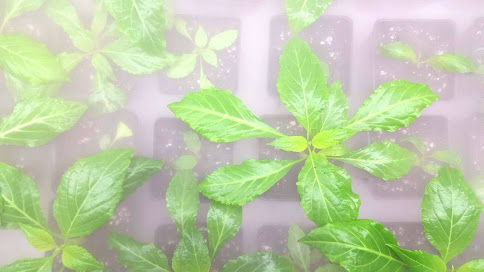
How to grow salvia divinorum
Diviners sage grows wild in the cloud forest of Sierra Mazateca which is both humid and cool. Temperatures are on average in the 60s(F) and the humidity hovers in the 60% range. When cultivating any plant it's best to mimic its natural environment the best you can. Although, this is not always practical....or convenient.
1. KEEP HUMIDITY HIGH IF YOU CAN

Salvia divinorum plants love humidity! Staying at or above 60% seems ideal and can be accomplished in lower humidity environments with a greenhouse(outdoors) or a growth chamber called a "shotgun terrarium" for indoor plants. A shotgun terrarium is typically used by mushroom cultivators for its humidity holding capabilities as well as allowing fresh air to circulate; but the best thing in my opinion is its low maintenance! The chamber is simply a clear storage bin completely covered with small holes(get it? shotgun) and filled several inches with wet perlite. Tutorials for making a shotgun terrarium can be found with a quick google search. Another good option for maintaining high humidity would be placing the plants in an open tote and allowing an ultrasonic fogger/humidifier on a timer to fill the tote periodically.
For those who want to skip the hassle of regulating their humidity salvia divinorum can be acclimated by slowly introducing it to the open air. Old leaves will distort and become unhealthy, but new growth should be fairly healthy as long as the plant is in good condition. The Bounty botanicals grow room is around 30% humidity on average to give you an idea of what salvia can adapt to.
2. KEEP TEMPS COOL
Temps in the mid 70s - low 80s(F) seem to be ideal.
3.KEEP OUT OF INTENSE LIGHT
Intense sunlight or HID lighting may prove too much for your salvia to handle. Salvia grows on the forest floor and is shaded by the tree canopy. If growing indoors then fluorescent lighting or leds that are not too intense works great. For outdoor plants heavy shade is recommended.
4. GROW IN GOOD SOIL
Choose a soil that is slightly acidic(most potting soils are) , high in composted matter, and very well draining. A good potting soil with some added perlite works great. I like to use Ocean Forest mixed with Happy Frog(not a sponsor) at about a 50/50 ratio and add extra perlite to this mix for extra drainage.
5. WATERING
Salvia likes consistently moist soil...but also lots of air around its roots.
- It can be difficult to keep a good soil moisture balance and takes time to get the hang of things.
- Do not rely on time to tell you when to water. Many factors such as growth rate, temps and humidity, among other factors directly correlate to how much and how often your plant will need to be watered. Since these conditions are constantly changing, so will the watering needs of your plants.
6. FERTILIZE REGULARLY
Use a mild vegging fertilizer at regular intervals following the labels instructions. Don't use at full strength. Start at 1/4th strength and go from there.
7. DO NOT LET THEM GET ROOT BOUND
Ive found that root bound plants perform poorly so its a good idea to transplant often and or use fabric pots.
That's about it folks!
